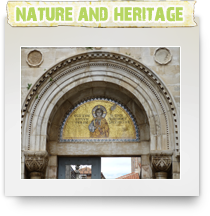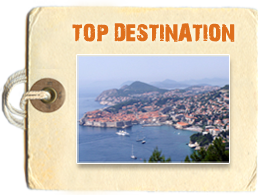
Croatia can be proud of it`s six cultural, historical and natural sights registered in the UNESCO's registry of world monument heritage. These are: Basilica of Euphrasius in Porec, Diocletian's Palace in Split, the old town square in Trogir, the Sibenik cathedral, the beautiful old town of Dubrovnik and the National Park Plitvice Lakes.
The group of religious monuments in Porec, where Christianity was established as early as the 4th century, constitutes the most complete surviving complex of its type.
The basilica, atrium, baptistery and episcopal palace are outstanding examples of religious architecture, while the basilica itself combines classical and Byzantine elements in an exceptional manner.
The Episcopal complex of the Euphrasian Basilica in the historic centre of Porec is an outstanding example of an early Christian episcopal ensemble that is exceptional by virtue of its completeness and its unique Basilican cathedral. This Basilica is the most precious cultural monument in the city of Porec, comprising a 6th-century complex of sacral buildings erected during the time of Bishop Euphrasius, lies in the northeast part of the urban-historical core of the city. The Basilica, built on the foundations of a much earlier church, is dominated by a triple-naved apse, a narthex, the atrium, an octagonal baptistery, and the bishop's palace. The edifice was added to in the 13th and 15th centuries, and a bell-tower was erected in the 16th century. The apse is ornately decorated with figural mosaics, which, together with the mosaics in San Vitale in Ravenna, comprise one of the most remarkable examples of mosaic art in Europe. From the floor mosaics and from preserved inscriptions we are able to follow all the phases of building, adaptations and renovations, that is to say, the dynamics of the life of the Christian community in Porec.
The ruins of Diocletian's Palace, built between the late 3rd and the early 4th centuries A.D., can be found throughout the city. The cathedral was built in the Middle Ages, reusing materials from the ancient mausoleum. Twelfth- and 13th-century Romanesque churches, medieval fortifications, 15th-century Gothic palaces and other palaces in Renaissance and Baroque style make up the rest of the protected area. The Roman Emperor Diocletian spent his final years here , in an huge palace that he had built near his birthplace, Aspalthos, today called Split (Spalato).
Trogir is a remarkable example of urban continuity. The orthogonal street plan of this island settlement dates back to the Hellenistic period and it was embellished by successive rulers with many fine public and domestic buildings and fortifications. Its beautiful Romanesque churches are complemented by the outstanding Renaissance and Baroque buildings from the Venetian period.
Trogir is an excellent example of a medieval town built on and conforming with the layout of a Hellenistic and Roman city that has conserved its urban fabric to an exceptional degree and with the minimum of modern interventions, in which the trajectory of social and cultural development is clearly visible in every aspect of the townscape.
Trogir was founded by Greek colonists from the Island of Vis in the 3rd century BC. On this Antique matrix lies the historical core of Trogir, which is the best-preserved Romanesque-Gothic complex not only in the Adriatic but in all of Central Europe. Trogir's medieval core, surrounded by walls, comprises a preserved castle and tower and a series of dwellings and palaces from the Romanesque, Gothic, Renaissance and Baroque periods. Trogir's grandest building is the church of St. Lawrence, whose main west portal is a masterpiece by Radovan, and the most significant work of the Romanesque-Gothic style in the country.
The Cathedral of St James (Katedrala SVetog Jakova) in Šibenik (1431-1535), on the Dalmatian coast, bears witness to the considerable exchanges in the field of monumental arts between Northern Italy, Dalmatia and Tuscany in the 15th and 16th centuries. The three architects who succeeded one another in the construction of the Cathedral - Francesco di Giacomo, Georgius Mathei Dalmaticus and Niccolò di Giovanni Fiorentino - developed a structure built entirely from stone and using unique construction techniques for the vaulting and the dome of the Cathedral. The form and the decorative elements of the Cathedral, such as a remarkable frieze decorated with 71 sculptured faces of men, women, and children, also illustrate the successful fusion of Gothic and Renaissance art. The structural characteristics of the Cathedral of St James in Šibenik make it a unique and outstanding building in which Gothic and Renaissance forms have been successfully blended. The Cathedral of St James is the fruitful outcome of considerable interchanges of influences between the three culturally different regions of Northern Italy, Dalmatia, and Tuscany in the 15th and 16th centuries. These interchanges created the conditions for unique and outstanding solutions to the technical and structural problems of constructing the cathedral vaulting and dome. The Cathedral of St James in Šibenik is a unique testimony to the transition from the Gothic to the Renaissance period in church architecture. Sibenik Cathedral was awarded Unesco's World Heritage Status in 2000.
The 'Pearl of the Adriatic', situated on the Dalmatian coast, became an important Mediterranean sea power from the 13th century onwards. Although severely damaged by an earthquake in 1667, Dubrovnik managed to preserve its beautiful Gothic, Renaissance and Baroque churches, monasteries, palaces and fountains. Damaged again in the 1990s by armed conflict, it is now the focus of a major restoration programme co-ordinated by UNESCO. Dubrovnik was founded in the 7th century and it is encompassed with 2 km long walls considered to be among the most massif defence fortifications in Europe. The city walls are 25 m high and 6 m thick and include 36 forts, towers and fortresses. They are encircled with beautiful streets consisting of houses and palaces from all periods of the famous Dubrovnik Republic.
Plitvicka Jezera (Plitvice Lakes) is Croatia's well known national park. Plitvice Lakes are also listed in UNESCO's Register of World Natural Heritage. Plitvice Lakes is a group of sixteen small lakes - Proscansko Jezero, Labudanovac Lake , Ciganovac Lake , Galovac Lake, Kozjak Lake... - mutually conected with numerous large and smaller waterfalls. Plitvice waterfalls are created by deposition of travertine -a kind of limestone that created this unique and attractive wonder of nature.
Plitvice National Park is the area surrounded by dense forests of beech, fir and spruce, watered by varous springs of the Korana River.
Plitvice National Park is decorated with several caves and flower meadows too. Brown bear found , among other animal species, their home in Plitvica Lakes too.
Area of Plitvice Lakes is paradise for walkers and hikers as well as nature lovers. Lakes are lovely and cool in summer, icy and calm in winter, yellow and ocre in autumn, green and fresh in spring - any time of the year it is a priviledge to be around those lakes!
Plitvice Park is conveniently located near the main road that connects Zagreb and Croatia Adriatic Coast. It is easily accessible by public transport as well as by bicycle, from Karlovac, Zagreb or Split. Due to it's popularity among Croatian as well as other visitors, there are various accommodations available in and around Plitvice Lakes.





